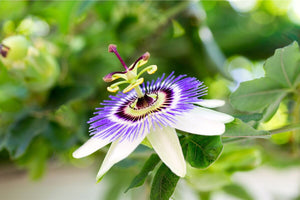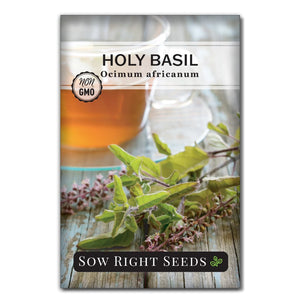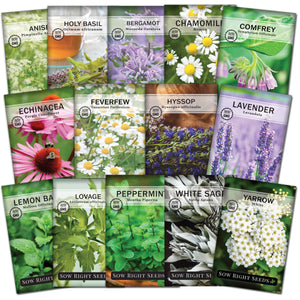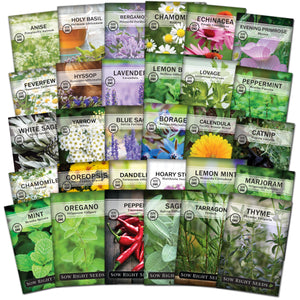How to Grow Feverfew Plants from Seed
Medicinal herbsFeverfew is a beautiful perennial flower that has many uses as a medicinal herb. This easy-to-grow plant may just be what you need in your healing garden.

How to Grow, Harvest, and Use Feverfew
Feverfew (Tanacetum parthenium), also known as wild chamomile, is a perennial herb in the Asteraceae family that is commonly found growing in rocky soil along roadsides. Feverfew got its name from its use in traditional medicine to treat - you guessed it - fevers! While feverfew leaves are edible, they are also incredibly bitter, making the herb best known for its medicinal uses over other edible uses.
Feverfew is also a beautiful ornamental plant. Small white flowers with sunny yellow centers cover the green plants. It can be grown in all kinds of flowerbeds and containers.
How to Plant Feverfew Seeds
Feverfew seeds can be sown outside after all danger of frost is passed. Seeds can also be started indoors 6 to 8 weeks before the last spring frost.
Plant seeds ¼” deep. Be careful not to plant too deep as feverfew seeds need light to germinate.
Keep soil moist until seeds germinate in 10 to 14 days.
The optimal soil temperature for feverfew seed germination is 60-70ºF.

Transplanting Feverfew Seedlings
Once seedlings are several inches tall and have at least one set of true leaves, they are ready for transplanting outdoors.
For successful transplanting, wait until all danger of frost is passed and harden off seedlings. Space feverfew plants 12-18" apart.

How to Grow and Maintain Feverfew Plants
Soil
Plant feverfew in well-draining loamy soil. Feverfew can grow in average garden soil with a pH of 6.0 to 6.7.
Sun
Feverfew grows best in full sun to partial shade.
Water
Keep young feverfew seedlings well watered. Once feverfew plants are established, they can tolerate drought. To keep plants growing well and producing blooms, water once a week.
Hardiness
Feverfew is hardy to zone 5. With protection from extreme temperatures, it can also overwinter in zone 4. Check your hardiness zone.

Harvesting Feverfew
Feverfew is ready to harvest in the second year. This plant will self-seed and spread, so if you want to control its growth, cut flowers before they go to seed.
Harvest the leaves and flowers once the flowers are in full bloom around mid-July. The essential oils are at their most potent when the flowers start to bloom.
Use sharp scissors to snip off stems. Do not harvest more than ⅓ of the plant to ensure it survives into the following year.
Hang harvested stems and leaves in a dry place away from sunlight. You can also place feverfew leaves and flowers on a wire rack to dry.
Once dried, store feverfew in an airtight container in a cool, dark location.
Feverfew Medicinal Uses
As mentioned earlier, feverfew was and still is a treatment for fevers, colds, flu pain, and even colic! Feverfew has analgesic (pain relieving), anti-inflammatory, and diaphoretic (fever-breaking) properties. Because of these activities, a hot cup of feverfew tea helps break fevers and treats the aches and pains that come with a cold or flu. For colic in babies and small children, use just a few drops of a cold infusion instead.
When taken regularly, feverfew is effective at preventing migraines and treating tension headaches. The leaves and flowers can be made into a tea or tincture, but some people with migraines may find that keeping a small bag of dried feverfew leaves on hand is an easy and convenient way to combat their migraines. Simply chewing 1-4 leaves per day can prevent migraines (2-3 leaves is a typical dose), with a proportionally lower dose for children. Note: regularly chewing feverfew leaves can result in mouth sores. Consuming feverfew in tea, tincture, or capsule is still an effective method.
Additionally, feverfew is a good choice for relieving painful cramping during menstruation. It will also bring on menses, as it is a uterine stimulant.
Feverfew Tea
To take as a tea, steep 1 heaping teaspoon of feverfew leaves and flowers per 1 cup of hot water. Drink once lukewarm. Feverfew tea can also be applied topically.
Dried feverfew leaves can be powdered and taken as capsules.
Warnings
Mouth sores can develop from chewing the leaves. Those allergic to ragweed, marigold, or chrysanthemum may also experience an allergic reaction to feverfew, such as contact dermatitis. Feverfew causes contractions, so do not use it if pregnant. People with blood coagulation problems should not use feverfew.
Feverfew is a beautiful plant that has many medicinal uses. Add this easy-to-grow perennial herb to your healing garden.
Written by Ashley Clark










Leave a comment